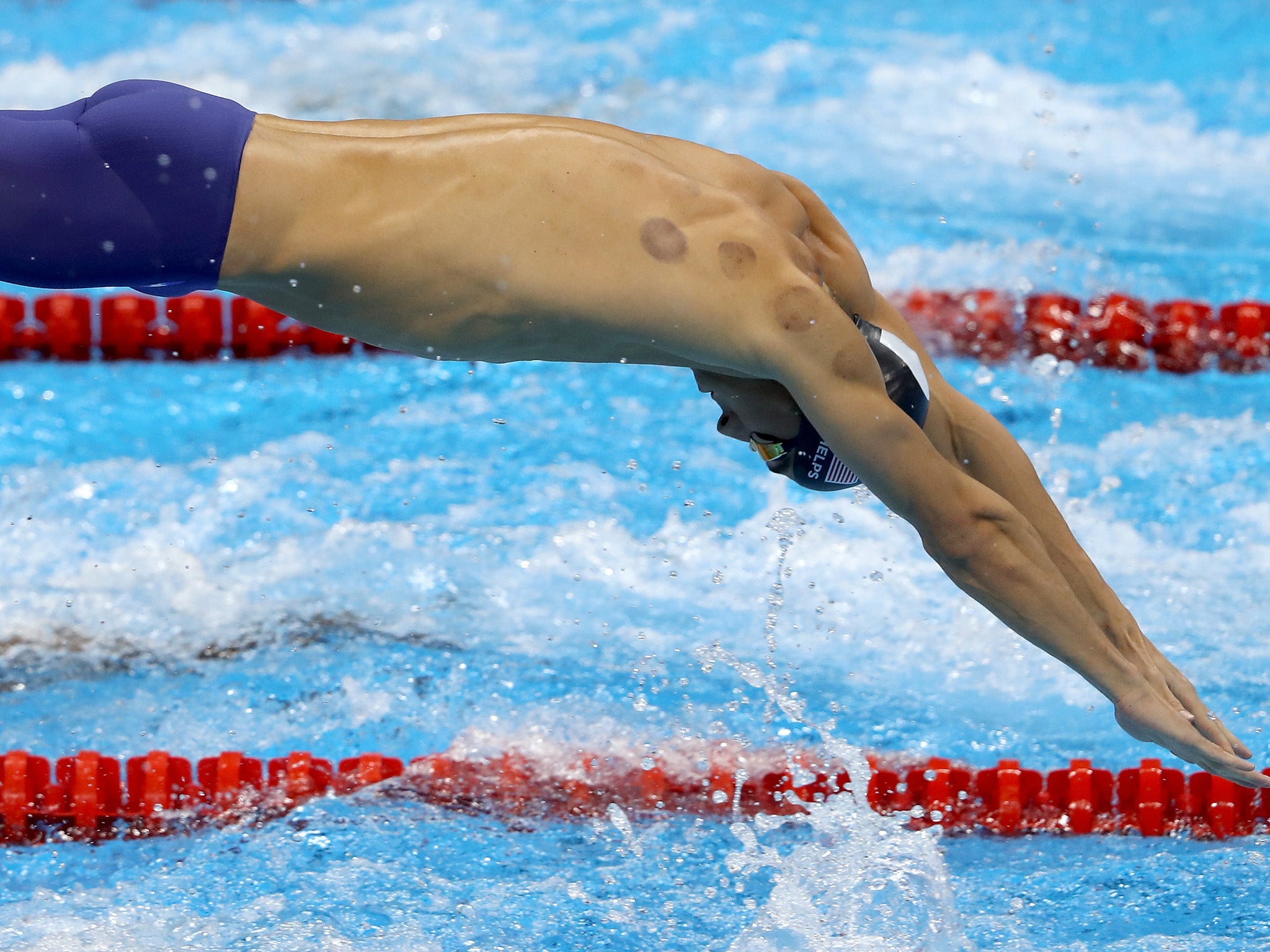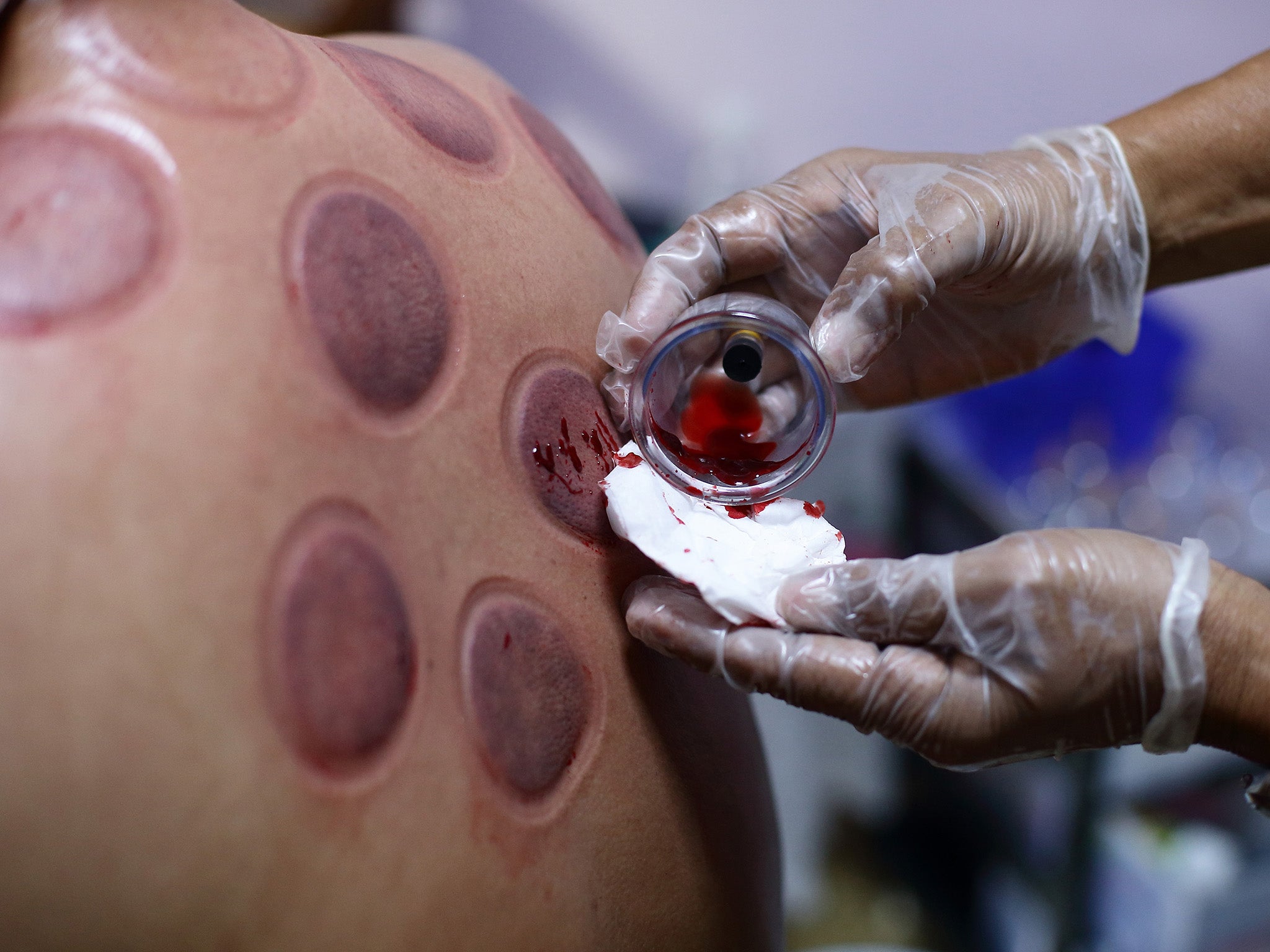Rio 2016: What is ‘cupping’ and why are Olympic athletes doing it?
UCL professor describes possibility of benefit from treatment as ‘desperately implausible’
Your support helps us to tell the story
From reproductive rights to climate change to Big Tech, The Independent is on the ground when the story is developing. Whether it's investigating the financials of Elon Musk's pro-Trump PAC or producing our latest documentary, 'The A Word', which shines a light on the American women fighting for reproductive rights, we know how important it is to parse out the facts from the messaging.
At such a critical moment in US history, we need reporters on the ground. Your donation allows us to keep sending journalists to speak to both sides of the story.
The Independent is trusted by Americans across the entire political spectrum. And unlike many other quality news outlets, we choose not to lock Americans out of our reporting and analysis with paywalls. We believe quality journalism should be available to everyone, paid for by those who can afford it.
Your support makes all the difference.Why do some of the world’s top athletes look as though they’ve been on the receiving end of a brutal paintball firing squad?
US swimmer Michael Phelps’s skin is strewn with livid polka dots, and his compatriot, the gymnast Alex Naddour is also sporting circular welts.
But this is not the result of a corporate team-building exercise. The athletes are among the latest adherents to the traditional Chinese medicine treatment known as “cupping”.
This involves having hot suction cups applied to the skin for several minutes, leaving what appears to be a circular love bite on the surface, which can take over two weeks to fade.
The technique has been used for millennia, but it shot to prominence in 2004, when US actor Gwyneth Paltrow attended a film premier with circular marks peppering her skin.
Other celebrity endorsements followed, with Victoria Beckham and Jennifer Aniston among those sporting the circular suction marks on their skins.
But the Rio Olympics provides us with growing evidence that athletes are turning to the alternative medicine in an attempt to boost their performance.
According to Mr Naddour he has found the treatment “provides relief from the soreness and pounding that come from gymnastics”.
He told USA Today: “That's been the secret that I have had through this year that keeps me healthy. It's been better than any money I've spent on anything else.”
“It has saved me from a lot of pain.”

Cupping is claimed by its practitioners to treat an array of ailments, including muscular pain, joint pain, skin problems including eczema and acne, respiratory disorders, including the common cold, pneumonia and bronchitis, and has also been used as an alternative treatment for cancer.
Speaking to the Independent, Dr Ayaaz Farhat, the co-director of the London Cupping Clinic said: “The use of cupping therapy amongst athletes has grown over the last decade. Wang Qun, the then teenage Chinese swimmer being the most obvious in Beijing Olympics. Since then, Floyd Mayweather, Andy Murray, Amir Khan and more recently the Olympians in Rio have all been seen with cupping marks.
“Their increased use is for the same reason that freeze tanks or oxygen rich blood injections are used by International sports teams and premiership footballers – to recover from the inevitable strains and knocks in time for the next round of competition.
He added: “It's not straight forward to prove how effective it is as there is such a vast range of injuries that we see, both in terms of anatomy but also the underlying cause for that problem. But simply it is a very effective way to enhance, encourage and even accelerate the body's own immune response to injury.
“The main benefits are encouraging the inflammatory response of the body and speeding up muscular and soft tissue recovery after injury and strain. Cupping therapy has widened significantly though in the last few years and newer techniques are being used for conditions and diseases away from sports therapy such as migraines and eczema.”
Dr Farhat's colleague and co-director of the London Cupping Clinic, Yasin Zaman added that cupping remains a "learning process", as the team understands the impacts of the treatment on athletes.
However, there is currently scant evidence the technique has any detectable benefit in treating any physical malady.
In their 2008 book Trick or Treatment, science author Simon Singh, and former professor of complementary medicine at the University of Exeter, Edzard Ernst, wrote that the technique “has a long history but there is no evidence that it generates positive effects in any medical condition.”

David Colquhoun, professor of pharmacology at University College London told the Independent: “There’s no science behind it whatsoever. There’s some vague conceptual connection with accupunture, and is often sold by the same people. But how could it possibly do anything? It’s nonsense.
“It’s not for scientists to show how it can’t work, but it’s their [practitioners’] business to prove that it does work, which they haven’t done.
“But it’s desperately implausible, how the hell should sucking up a bit of skin in a cup do anything to your athletic performance?
He added: “If it’s done enough to cause bruising, it is [breaking blood vessels], and that’s not going to help anybody is it?”
When asked if he thought Olympic teams using cupping may have any advantage over their rivals, Dr Colquhoun said: “Not at all. If anything they’ll have a slight disadvantage because they’re wasting time getting cupped”.
But cupping is clearly not having much of a detrimental impact on Mr Phelps, who (at the time of writing) has chalked up his 19th Olympic Gold medal.

Join our commenting forum
Join thought-provoking conversations, follow other Independent readers and see their replies
Comments